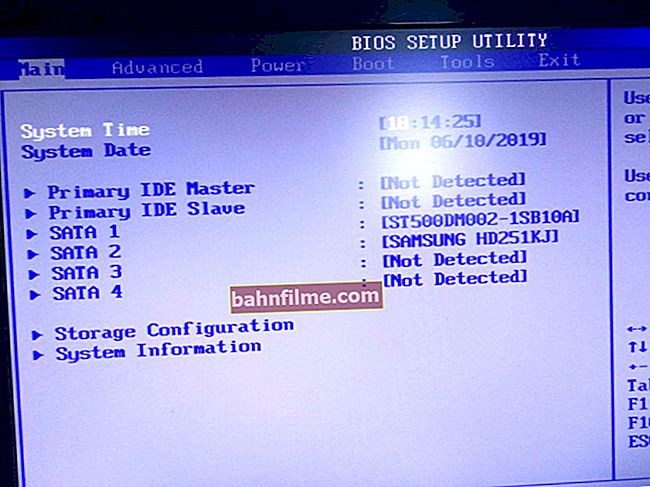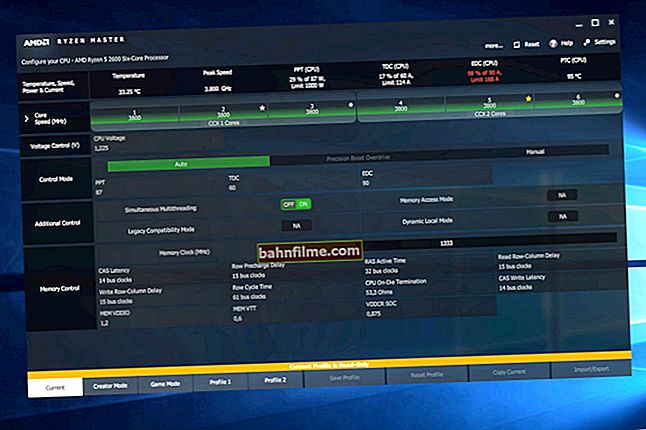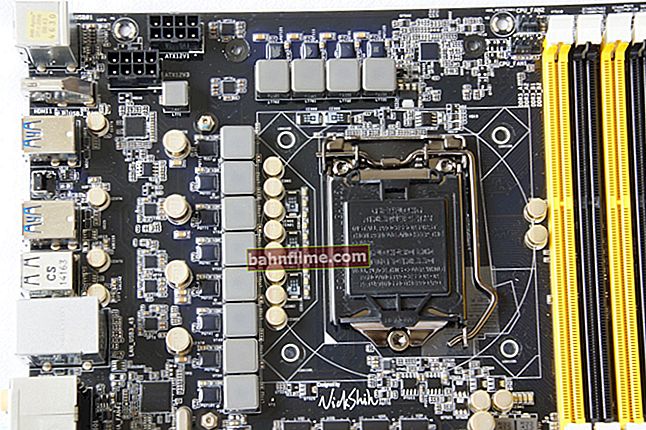 Good time!
Good time!
I thought for a long time whether to publish today's article, because the question is rather controversial (and the result after configuration may vary for everyone, depending on the hardware and software). And yet, I ask you to treat the article critically and as an "experimental" ...
And so, closer to the topic. Windows does not always work "perfectly" with multi-core processors. In order to reduce power consumption, a number of processes can be performed on the core on which they were originally launched (this approach allows: on the one hand (positive) - not to use all the cores all the time (and thereby reduce power consumption), and on the other (negative ) - does not allow the processor to work to its fullest).
In addition, the function parking cores allows the processor (under a certain load) to transfer all tasks to one core, and put the rest into standby mode (i.e., only one core will actually work). Naturally, this reduces overall performance (although it makes the system more responsive, but only slightly). Note that Windows also does not work correctly with parked cores on Intel processors (at least Windows 7).
So, by setting certain power settings, you can limit the operation of the core parking function and increase overall performance (in some cases, up to 20%!). In my opinion, it makes sense to try to spend 3-5 minutes. on the "experiment"!
Note: first of all, this topic concerns multi-core processors from Intel (to be honest, I don't have adequate statistics on AMD. But you can try ...).
*
How to fine-tune the processor power supply
In order not to be unfounded about improving performance, I will give one small performance test in WinRAR (official site of the archiver). In the screenshot below: on the left, you can see the overall speed before the settings were optimized; on the right - after. Even with the naked eye, you can see that in tests the CPU starts to work faster (which has a positive effect in real tasks, the same games, for example).

Performance difference
Note: I recommend that you run the test in WinRAR first before optimizing the settings (and remember the overall speed), and then run the test after optimization. Then just compare these numbers, in some cases it is possible to squeeze another 10-20% out of the CPU!
An important point!
As I said above, this issue primarily concerns multi-core processors (4 cores and higher). To find out the number of cores of your CPU, just run the CPU-Z utility, and look at the bottom of the window: in the Cores column, you will see the number of cores (example below).

CPU-Z - 4 Cores (4 cores, 8 threads)
1) And so, you need to start by setting the registry.
The point is that Windows hides some of the power settings by default. To open them for editing, you need to make certain changes to the registry. The easiest way to do this is using a ready-made settings file, which you just need to run and agree to adding parameters to the system registry. Here is the prepared file: core_parking (you need to extract it from the archive and run it. The archive is packed using WinRAR, relevant for Windows 7-10).

Registry Editor - Settings have been successfully entered into the registry
Just in case, I will give the text of this file a little below (for security purposes, suddenly someone doubts the file and wants to make changes to the registry manually).
[HKEY_LOCAL_MACHINE \ SYSTEM \ CurrentControlSet \ Control \ Power \ PowerSettings \ 54533251-82be-4824-96c1-47b60b740d00 \ 0cc5b647-c1df-4637-891a-dec35c318583]
"Attributes" = dword: 00000000
[HKEY_LOCAL_MACHINE \ SYSTEM \ CurrentControlSet \ Control \ Power \ PowerSettings \ 54533251-82be-4824-96c1-47b60b740d00 \ 3b04d4fd-1cc7-4f23-ab1c-d1337819c4bb]
"Attributes" = dword: 00000000
[HKEY_LOCAL_MACHINE \ SYSTEM \ CurrentControlSet \ Control \ Power \ PowerSettings \ 54533251-82be-4824-96c1-47b60b740d00 \ 5d76a2ca-e8c0-402f-a133-2158492d58ad]
"Attributes" = dword: 00000000
[HKEY_LOCAL_MACHINE \ SYSTEM \ CurrentControlSet \ Control \ Power \ PowerSettings \ 54533251-82be-4824-96c1-47b60b740d00 \ a55612aa-f624-42c6-a443-7397d064c04f]
"Attributes" = dword: 00000000
[HKEY_LOCAL_MACHINE \ SYSTEM \ CurrentControlSet \ Control \ Power \ PowerSettings \ 54533251-82be-4824-96c1-47b60b740d00 \ ea062031-0e34-4ff1-9b6d-eb1059334028]
"Attributes" = dword: 00000000
2) Setting up the power scheme
Now you need to open the Windows Control Panel section "Hardware and Sound / Power Supply" ... Then go to the settings of the current power supply scheme (i.e. the one that you are currently using). In my case it is balanced (see screenshot below).

Setting the current power plan
Next, you need to open additional power settings.

Change advanced power settings
Now the most important thing (see screenshot below):
- minimum idle cores: it is recommended to set this value to 99% (for some reason, if you set 100% - Windows often sends one core to "rest");
- enable power down state: switch to mode off... (prevents the processor from saving energy);
- disable processor idle: set the mode to off;
- minimum processor state: 100% (slightly speeds up the CPU (by the way, in some cases it can reduce the squeak from the throttles)).
- system cooling policy: active (cools the CPU more efficiently);
- maximum processor state: 100% (greatly affects performance! Be sure to set it to 100%);
- maximum idle cores: 100% (a contradictory option. If you set something different from 100%, then for some reason not all kernels are loaded, despite the fact that all are active ...).

Additional power options
Save your settings and restart your computer!
3) Once again about the power mode (applies primarily to laptops)
After restarting the computer (laptop) - pay attention to the power mode (click on the battery in the tray). Set your productivity to 100%!

Max. performance
In addition, pay attention to the laptop control centers that may come with your drivers (for example, devices from Lenovo, Sony, etc.). They also need to put the device into high performance mode.

Laptop power // laptop manager
4) Testing performance
Then you can start WinRAR and run a performance test. As a rule, after fine tuning the power supply, an increase in numbers is observed (since the system ceases to limit the CPU, and it can start working at its full potential).

Testing - WinRAR / Clickable
Addition!
To see how the load on the CPU cores is going - open "Task Manager" (Ctrl + Shift + Esc) and go to the tab "Performance" ... Next, right-click on the CPU load graph and select from the menu "Change Schedule / Logical Processes" ... See screenshot below.

Task Manager - Performance
As a result, you will have not one graph, but several, depending on the number of cores (threads).

All kernels loaded
Please note, under load (for example, testing) - ideally, all kernels should be loaded (as in the screenshot below).

Under load
For a more indicative CPU test, I recommend using the utility AIDA64 (I give a link to the instructions below).
To help!

How to perform a stress test of the processor and the system as a whole, does it hold frequencies, is there overheating (AIDA 64) - //ocomp.info/kak-vyipolnit-stress-test-videokartyi-noutbuka-v-aida-64.html
PS
Within the framework of this article, I cannot but recommend another article on a similar topic. It concerns primarily laptops (because in some cases Turbo Boost is disabled in their default settings, as a result of which the device works slower than it could potentially ...).
To help! Because of what the low performance of the Intel processor on the laptop. How can you speed it up? (about Turbo Boost) - //ocomp.info/increase-performance-intel-for-laptop.html
*
That's all for now ...
Happy work! 👋









